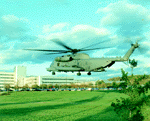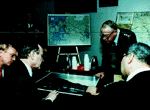JPEG
 (128.2 Kbytes)
(128.2 Kbytes)CH-53 helicopter landing in front of the Defense Intelligence Analysis Center at Bolling Air Force Base, Washington, D.C.
DIA's publication in 1981 of the first in a series of white papers on the strengths and capabilities of Soviet military forces titled, "Soviet Military Power", met with wide acclaim. Ten such booklets were published subsequently over roughly the next decade. In April of 1981, the Agency broke ground for the Defense Intelligence Analysis Center (DIAC) at Bolling Air Force Base in Washington, D.C. World crisis continued to flare and included the downing of two Libyan SU-22's by American F-14's over the Gulf of Sidra, an Israeli F-16 raid to destroy an Iranian nuclear reactor, two Iranian hijacking, Iranian air raids on Kuwait, and the release of American hostages in Iran.
As the decade wore on, DIA concentrated on enhancing its support to tactical and theater commanders, improving its capabilities to meet major wartime intelligence requirements, and strengthening DoD's indications and warning system. DIA established a position for a functional manager for intelligence processing in 1982. Two years later, the Central America Joint Intelligence Team (CAJIT) was established as an interagency analytic organization focused on Central American insurgency. DIA also created a standard intelligence communications architecture to improve DoD's ability to disseminate national-level intelligence to tactical commanders during contingency situations.
 (128.2 Kbytes)
(128.2 Kbytes)CH-53 helicopter landing in front of the Defense Intelligence Analysis Center at Bolling Air Force Base, Washington, D.C.
Closer to home, many of DIA's major functional elements were finally consolidated under one roof when the Agency dedicated the DIAC at Bolling AFB on 23 May 1984. Other DIA analytical efforts during the mid-1980's centered on the attack on the Marine barracks in Lebanon, the Iran Irac War, the conflict in Afghanistan, the Soviet shootdown Korean Air Lines Flight 007, the civil war in Chad, and unrest in the Philippines.
Indeed, the significantly large number of hijacking, bombings, kidnapping, murders, and other acts of terrorism led to 1985 being characterized the "Year of the Terrorist." Secretary of Defense Casper Weinberger presented DIA with the Agency's first Joint Meritorious Unit Award in 1986 for outstanding intelligence support over the previous year during a series of crises--the hijacking of TWA Flight 847 and the cruise ship ACHILLEA LAURO, unrest in the Philippines, and counterterrorist operations against Libya.
It was during this period that DIA developed its Operational Intelligence Crisis Center (OICC) in the DIAC as the primary vehicle for orchestrating analytic support during volatile situations. In addition, to relieve overcrowding in the DIAC, the Agency moved several elements into a leased office building at 3100 Clarendon Avenue in Arlington, VA.
Also at this time, the Agency concentrated on the rapidly shifting national security environment, characterized by key issues such as changes within the Soviet Union, counternarcotics, warfighting capabilities and sustainability, and low-intensity conflict. DoD moved decisively to improve its automated data bases and apply additional resources to the monitoring of terrorist groups, illegal arms shipments, and narcotics trafficking. Arms control monitoring also increased the demand for intelligence support from DIA.
 (100.1 Kbytes)
(100.1 Kbytes)President Bush receives briefing from DIA during Operation JUST CAUSE (Panama).
Intelligence support to U.S. allies in the Middle East intensified as the Iran-Iraq War spilled into the Gulf. DIA provided significant intelligence support to Operation EARNEST WILL while closely monitoring incidents such as the Iraqi rocket attack on the USS STARK, the destruction of Iranian oil platforms, and Iranian attacks on Kuwaiti oil tankers. The "Toyota War" between Libya and Chad and the turmoil in Haiti added to DIA's heavy production workload, as did unrest in other parts of Latin America, Somalia, Ethiopia, Burma, Pakistan, and the Philippines.
Subsequently, DIA oversaw a successful defense intelligence effort in support of U.S. operations in Panama which demonstrated the benefits of increased cooperation between DIA and operational force planners. At this time, the Agency also provided threat data on "hot spots" throughout the Middle East, Africa, and Asia, while assessing the impact of changes in the USSR, Eastern Europe, and, to a lesser degree, Asia. In addition, DIA supported decisionmakers with intelligence concerning the Soviet withdrawal from Afghanistan, events surrounding the shootdown of several Libyan jets, the civil war in Liberia, the investigation of the downing of Pan Am Flight 103 over Lockerbie, Scotland, and the Tienanmen Square incident. Weapons acquisition issues, counternarcotics, and counterterrorism, likewise, remained high priority issues.